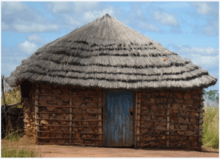Tipi
A tipi (/ˈtiːpiː/ TEE-pee), also tepee[1] or teepee[2] and often called a lodge in older English writings, is a tent, traditionally made of animal skins upon wooden poles. Modern tipis usually have a canvas covering.[3] A tipi is distinguished from other conical tents by the smoke flaps at the top of the structure.[4][5][6]
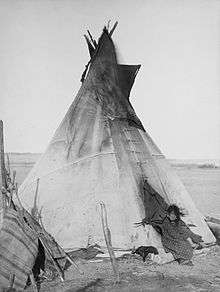
Historically, the tipi has been used by Indigenous peoples of the Plains in the Great Plains and Canadian Prairies of North America, notably the seven sub-tribes of the Dakota, among the Iowa people, the Otoe and Pawnee, and among the Blackfeet, Crow, Assiniboines, and Plains Cree.[7] They are also traditional on the other side of the Rocky Mountains by tribes such as the Yakama and the Cayuse. They are still in use in many of these communities, though now primarily for ceremonial purposes rather than daily living. While Native American tribes and First Nation band governments from other regions have used other types of dwellings,[3] tipis are often stereotypically and incorrectly associated with all Native Americans in the United States and indigenous peoples in Canada.[8]
The tipi is durable,[9] provides warmth and comfort in winter,[10] is cool in the heat of summer,[note 1] and is dry during heavy rains.[11][12] Tipis can be disassembled and packed away quickly when people need to relocate and can be reconstructed quickly upon settling in a new area.[13][14][note 2] Historically, this portability was important to Plains Indians with their at-times nomadic lifestyle.[15]
A similar structure, the lavvu, is used by the Indigenous Sámi people of northern Europe.[16][17][18]
Etymology and nomenclature
The word tipi comes into English from the Lakota language.[19] The Lakota word thípi [ˈtʰipi] means "a dwelling" or "they dwell", from the verb thí, meaning "to dwell".[20]
The wigwam or "wickiup", a dome-shaped shelter typically made of bark layered on a pole-structure, was also used by various tribes, especially for hunting camps.[21][22] The term wigwam has often been incorrectly used to refer to a conical skin tipi.[23][note 3]
The conventional translation in French and English for all indigenous dwellings at one time was "lodge", resulting many compounds and place names such as sweatlodge, lodgepole pine, Red Lodge, and so on.
Types and utility
Structure
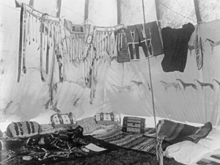
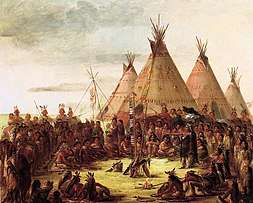
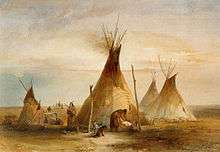
A typical family tipi is a conical, portable structure with two adjustable smoke flaps, multiple poles (historically from 12 to 25 feet long) called lodge poles. Lewis H. Morgan noted that,
The frame consists of thirteen poles from fifteen to eighteen feet in length, which, after being tied together at the small ends, are raised upright with a twist so as to cross the poles above the fastening. They are then drawn apart at the large ends and adjusted upon the ground in the rim of a circle usually ten feet in diameter. A number of untanned and tanned buffalo skins, stitched together in a form adjustable to the frame, are drawn around it and lashed together, as shown in the figure. The lower edges are secured to the ground with tent-pins. At the top there is an extra skin adjusted as a collar, so as to be open on the windward side to facilitate the exit of the smoke. A low opening is left for a doorway, which is covered with an extra skin used as a drop. The fire-pit and arrangements for beds are the same as in the Ojibwa lodge, grass being used in the place of spruce or hemlock twigs.[24]
Lodgepole pine is the preferred wood in the Northern and Central Plains and red cedar in the Southern Plains.[25] Tipis have a detachable cover over the structure. The cover has historically been made of buffalo hide, an optional skin or cloth lining, and a canvas or bison calf skin door. Modern lodges are more often made of canvas.[26]
Ropes (historically raw hide) and wooden pegs are required to bind the poles, close the cover, attach the lining and door, and anchor the resulting structure to the ground. Tipis are distinguished from other tents by two crucial elements: the opening at the top and the smoke flaps, which allow the dwellers to heat themselves and cook with an open fire; and the lining that is primarily used in the winter, which insulates. Tipis were designed to be easily set up or taken down to allow camps to be moved to follow game migrations, especially the bison. When dismantled the tipi poles were used to construct a dog- or later horse-pulled travois on which additional poles and tipi cover were placed.[3]
Tipi covers are made by sewing together strips of canvas or tanned hide and cutting out a semicircular shape from the resulting surface. Trimming this shape yields a door and the smoke flaps that allow the dwellers to control the chimney effect to expel smoke from their fires. Old style traditional linings were hides, blankets, and rectangular pieces of cloth hanging about four to five feet above the ground tied to the poles or a rope.[4]
Decoration
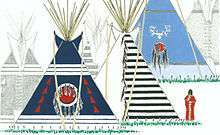
Historically, most tipis in a village would not be painted. Painted tipis often depicted note-worthy historical battles and often featured geometric portrayals of celestial bodies and animal designs. Sometimes tipis have been painted to depict personal experiences such as war hunting, a dream or vision. When depicting visions, "ceremonies and prayers were first offered, and then the dreamer recounted his dream to the priests and wise men of the community. Those known to be skilled painters were consulted, and the new design was made to fit anonymously within the traditional framework of the tribe's painted tipis."[27]
See also
- Chum (tent), a similar structure used by various peoples from northwestern Siberia to northern Mongolia.
- Goahti, a somewhat similar structure used by the Sami people of northern Scandinavia
- Oca, a typical Brazilian indigenous housing;
- Hogan
- Igloo
- Lavvu, a similar structure used by the Sámi people of northern Scandinavia
- List of human habitation forms
- Longhouse
- The Tepee
- Plains hide painting
- Wigwam Motel
- Yurt
- Lone Teepee, a historic place in Montana, US
- List of house types
References and notes
- General
- Holley, Linda A. Tipis-Tepees-Teepees: History and Design of the Cloth Tipi. Gibbs-Smith, 2007.
- Reginald Laubin, Gladys Laubin, Stanley Vestal, The Indian tipi: its history, construction, and use. Norman: University of Oklahoma Press, 1989, ISBN 978-0-8061-2236-6.
- American Anthropologist. Vol. 16; No. 1. American Anthropological Association of Washington, 1914.
- Citations
- "tepee". Dictionary.Cambridge.org. Retrieved 5 August 2020.
- "teepee". www.dict.org.(last visited August 25, 2013). And rarely, "tepee" tepee (dwelling) -- Encyclopædia Britannica
- Laubin, Reginald; Laubin, Gladys (2012). The Indian Tipi: Its History, Construction, and Use (2 ed.). University of Oklahoma Press. ISBN 978-0806188522.
- Holley, Linda A. Tipis-Tepees-Teepees: History and Design of the Cloth Tipi.
- The American Antiquarian and Oriental Journal, Volume 24. Edited by Stephen Denison Peet. p253
- History of Dakota Territory, Volume 1. By George Washington Kingsbury. S.J. Clarke Publishing Company, 1915. p147
- Lewis H. Morgan, "I have seen it in use among seven or eight Dakota sub-tribes, among the Iowas, Otoes, and Pawnees, and among the Black-feet, Crows, Assiniboines, and Crees. In 1878, I saw it in use among the Utes of Colorado. A collection of fifty of these tents, which would accommodate five hundred persons, make a picturesque appearance. Under the name of the "Sibley tent" it is now in use, with some modifications of plan, in the United States Army, for service on the plains." [A Sibley tent has one pole in the center and no flaps for guiding the smoke from the central fire.] (Contributions to N. A. Ethnology, vol. iv., p. 115.)
- National Museum of the American Indian (2007). Do All Indians Live in Tipis?. New York: HarperCollins. ISBN 978-0-06-115301-3.
- Annual Reports, Volume 17, Part 1. 1898. p405
- "Shelter". Anthropological Papers of the American Museum of Natural History, Volumes 5-6. Published by order of the trustees, 1910. p115
- The tipi: a center of native American life. By David Yue, Charlotte Yue. 1984. p. 15.
- Camping and Camp Outfits: A Manual of Instruction for Young and Old Sportsmen. By George O. Shields. Rand, McNally, 1890. p 43
- The North-Americans of yesterday. By Frederick Samuel Dellenbaugh. G.P. Putnam's Sons, 1900. p 204
- Lewis H. Morgan, "Houses and House Life of the American Aborigines," Contributions to N. A. Ethnology, vol. iv., p. 114.
- North American Indians of the Plains. By Clark Wissler. American Museum of Natural History, 1920.
- The People of Tipi Sapa (the Dakotas): Tipi Sapa Mitaoyate Kin. By Sarah Emilia Olden. Morehouse Publishing Company, 1918. p25
- Guide to the museum, first floor. By Museum of the American Indian, Heye Foundation. 1922. p105
- Geological Survey Professional Paper, Volume 670. U.S. Government Printing Office, 1969. p21
- Keoke, Emory Dean; Porterfield, Kay Marie (2009). Encyclopedia of American Indian Contributions to the World: 15,000 Years of Inventions and Innovations. Infobase Publishing. p. 264. ISBN 978-1-4381-0990-9.
- Ullrich, Jan (2012) [2008]. New Lakota Dictionary. Lakota Language Consortium. p. 525. ISBN 978-0-9761082-9-0. LCCN 2008922508.
- The Mythology of All Races. 1916. p. 76.
- The Archeological History of New York, Issues 231-238. By Arthur Caswell Parker. University of the State of New York, 1922. p387
- The North-Americans of yesterday. By Frederick Samuel Dellenbaugh. G.P. Putnam's Sons, 1900. p200
- Morgan, Lewis H., Contributions to Native American Ethnology, vol. iv., p. 114.
- Wishart, David J.. Encyclopedia of the Great Plains Indians. Lincoln: University of Nebraska Press, 2007. 89.
- The Indian Tipi: Its History, Construction, and Use By Gladys Laubin, Reginald Laubin. p3, p58.
- Goble, Paul (2007). Tepee: Home of the Nomadic Buffalo Hunters. USA: World Wisdom Books. p. 42. ISBN 978-1-933316-39-0.
- Notes
- With the sides raised; As seen in: Anthropological papers. 1917. p211
- Lewis H. Morgan notes the Dakota call their skin tents, "wii-ka-yo". The following is an extract of his text:
"When first discovered the Dakotas lived in houses constructed with a frame of poles and covered with bark, each of which was large enough for several families. They dwelt principally in villages in their original area on the head-waters of the Mississippi, the present State of Minnesota. Forced upon the plains by an advancing white population, but after they had become possessed of horses, they invented a skin tent eminently adapted to their present nomadic condition. It is superior to any other in use among the American aborigines from its roominess, its portable character, and the facility with which it can be erected and struck. "[...]" When the tent is struck, the poles are attached to a horse, half on each side, like thills, secured to the horse's neck at one end, and the other dragging on the ground. The skin-covering and other camp-equipage are packed upon other horses and even upon their dogs, and are thus transported from place to place on the plains. This tent is so well adapted to their mode of life that it has spread far and wide among the Indian tribes of the prairie region." (Contributions to N. A. Ethnology, vol. iv., p. 114.) - Usually wigwams are a domed structure; conical wooden wigwams are known (as seen here in the background), though, and presumably gave rise to the confusing of the different structures. For more, see: Notes on the Eastern Cree and Northern Saulteaux, Volumes 9-10. By Alanson Skinner. The Trustee, 1911. p12+13.
External links
| Wikimedia Commons has media related to Tipis. |
- History, construction, and evolution of tipis plus Photos and drawings
- Simply Differently.org: Tipi, tipi building resource, how-to manuals and online calculator for canvas lanes
- Tipi Instructions, a PDF document detailing the construction of a tipi.
- Tipi Mongolia
.svg.png)
